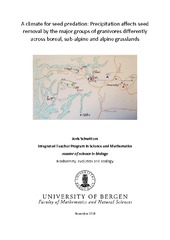| dc.description.abstract | Granivory, the seed predation by animals, plays an important role for plant and animal populations, and impact species composition and functioning of ecosystems. The intensity in granivory depends on various biotic and abiotic factors, including animal groups, seed type, vegetation structure and environmental conditions. We expect a warmer and more wet climate in the future, affecting both vegetation structure and productivity, but also animal abundance and activity. These changes are likely to affect animal-plant interactions, such as seed predation. Mountain calcareous grassland habitats are hotspots for alpine biodiversity, but also especially vulnerable to climate change. Therefore, understanding these underlying factors affecting plant species composition and selection pressure in alpine areas is critically important. To better understand underlying processes driving seed predation, a multi-species assessment was conducted to investigate how granivory rates by different animal groups (insects, rodents and birds) responded to both direct and indirect effects of temperature and precipitation. An exclusion method was used to quantify predation rates for the three granivorous animal groups separately, across three bioclimatic zones (boreal, sub-alpine and alpine) and along a precipitation gradient (spanning from 600-2700mm annual precipitation). In this system, we found that insects are the most active predators on boreal and sub-alpine zones (36% and 21% of available seeds predated, respectively), but their impact varies across sites and decrease with increasing precipitation. Birds are the dominant seed predator in the alpine zone with 49% of available seeds predated, which increased with precipitation. This trend is reversed in boreal and sub-alpine sites, reflecting an interaction between temperature zones and precipitation levels in governing bird seed predation. These interactions imply that responses to temperature must be put in context of precipitation, and vice versa, and that looking at one climate driver alone may give misleading conclusions. My study shows that the two climate variables, precipitation and temperature, are both affecting seed predation, but in interacting ways that also differs between animal types. The dominance in predation by some of the animal groups in some sites also show that animal groups prefer different physical conditions and vegetation structures. Further research on seed preference, responses in predation to vegetation structures and climate parameters could potentially give an indication on how animal-plant interactions in alpine environment will look like in the future. | en_US |
